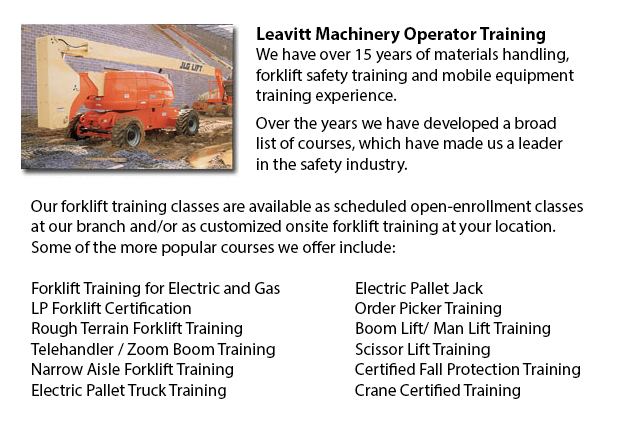
Coquitlam Boom Lift Certification - Using elevated work platforms allow for maintenance operations and work to be carried out at elevated work heights that were otherwise unreachable. Workers making use of scissor lifts and boom lifts can be taught the safe operation of these devices by getting boom lift certification training.
Despite the array in lift style, applications and site conditions, all lifts have the potential for death or serious injury when not safely operated. Electrocution, falls, tip-overs and crushed body parts could be the tragic result of incorrect operating procedures.
In order to prevent aerial lift accidents, boom lift operators must be trained by qualified workers in safely operating the specific kind of aerial lift they will be utilizing. Aerial lifts should not be be modified without the express permission of other recognized entity or the manufacturer. If you are renting a lift, make certain that it is maintained correctly. Prior to using, safety devices and controls must be inspected in order to ensure they are properly functioning.
It is essential to follow safe operating procedures to be able to prevent workplace incidents. Driving an aerial lift while the lift is extended should not be done, however, some models are designed to be driven when the lift is extended. Always set brakes. Set outriggers, if available. Avoid slopes, but when needed use wheel chocks on slopes which do not go beyond the manufacturer's slope limitations. Follow manufacturer's weight and load restrictions. When standing on the platform of boom lifts, use a safety belt with a two-foot lanyard tied to the boom or basket or a full-body harness. Fall protection is not required for scissor lifts which have guardrails. Do not sit or climb on guardrails.
This course comprises the following topics: safety tips in order to prevent a tip-over; training and certification; surface conditions and slopes; checking the travel path & work area; stability factors; other guidelines for maintaining stability; weight capacity; leverage; pre-operational inspection; testing control functions; safe operating practices; mounting a vehicle; overhead obstacles and power lines; safe driving procedures; PPE and fall protection; using harnesses and lanyards; and avoid falling from the platform.
When successful, the trained worker would learn the following: pre-operational inspection procedures; authorization and training procedures; factors affecting the stability of boom and scissor lifts; how to avoid tip-overs; how to use PPE, how to use the testing control functions and fall prevention strategies.
-
Coquitlam Crane Certification
Coquitlam Crane Certification - The Crane Certification training program consists of subject matter recommended by industry concerning the safe and efficient operation of cranes. Trainees will be taught the following: how to identify cranes and their... More -
Coquitlam Crane Training Courses
Coquitlam Crane Training Courses - A crane is a kind of equipment designed to move, lift and lower heavy stuff. A crane is usually equipped with a hoist, sheaves, and chains or wire ropes. Cranes are used in the manufacturing, construction and transp... More -
Coquitlam Boom Lift Safety Training
Coquitlam Boom Lift Safey Training - Boom lifts are a kind of elevated work platform or aerial lifting device which are usually used in industry, warehousing and construction. Boom lifts can be utilized in virtually any setting due to their versatili... More -
Coquitlam Boom Lift Training
Coquitlam Boom Lift Training - Aerial platforms or also known as elevated work platforms are devices which allow workers to carry out duties and tasks at elevated heights that would not be otherwise reachable. There are different aerial lifts availab... More -
Coquitlam Forklift Certification Schools
Coquitlam Forklift Certification Schools - Forklift Certification is mandatory within North America. Hence, forklift training programs are important both for businesses and for people looking for jobs in industries as operators of forklifts. Forklift... More -
Coquitlam Wheel Loader Training
Coquitlam Wheel Loader Training - Normally, the different types of heavy equipment training are divided into 2 categories of equipment: those that have rubber tires and tracked vehicles. Tracked vehicles include items like for instance bulldozers, ex... More -
Coquitlam Heavy Equipment Training Schools
Coquitlam Heavy Equipment Training Schools - There are a lot of heavy equipment training schools to choose from. If you would like to get to the best, it is important to examine several factors of the school to be able to determine the level of educa... More -
Coquitlam Telehandler Training Courses
Coquitlam Telehandler Training Courses - Employers are responsible for making sure that their supervisory and operating personnel are trained to work proficiently making use of telehandler equipment. The skill level of workers should be assessed. If... More

Forklift Certification Coquitlam
TOLL FREE: 1-888-254-6157
Coquitlam, British Columbia
forkliftcertificationcoquitlam.com
Email Us
About Us


